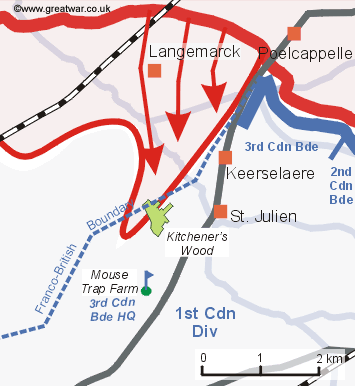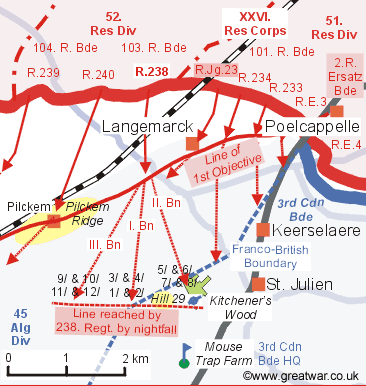 British heavy guns captured in Kitchener's Wood
British heavy guns captured in Kitchener's Wood
22 April 1915: 19.00
The regimental history of the 238 Reserve-Infanterie-Regiment, in 52. Reserve Division, describes the advance of the regiment during the afternoon of 22 April. By about 7pm the 8. Company of this regiment had captured the south part of Kitchener's Wood, including four heavy British guns.
Kitchener's Wood

This was a large wood of oak trees. Its Belgian name at the time was “Bois des Cuisiniers”. At the time of the Great War Ypres was in a French speaking region of Belgium. Today it is a Flemish speaking region. Because so many place names in Belgium were difficult to pronounce for the British troops, an English equivalent was frequently adopted. In the case of this wood, the literal translation from the French noun “le cuisinier” should be “Cooks' Wood”.
The reason why this wood gained the name of “Kitchener's Wood” is not known. The first British troops to take over this sector from the French were from the 1st Canadian Division in mid April 1915.
It might have been that the similarity of “le cuisinier” and “la cuisine”, the French noun for “kitchen”, resulted either in a mistranslation or a play on words leading to “cuisinier” becoming “kitchener”. It was often the case that the “new” English place name was influenced by a person or place familiar to the troops in the line when it was created. The name of Field Marshal Earl Kitchener, the British Secretary of State for War, may possibly have been an influence in the renaming of this wood as “Kitchener's Wood”.
Little Enemy Resistance South of Langemarck
Oberleutnant Mattenklott, commander of the 8. Company (in II. Battalion, 238 Reserve-Infanterie-Regiment), said that he was suprised not to meet enemy resistance or fortifications west or south-west of Langemarck:
“Following our battle orders we made a half turn to the right [i.e. to the south-west] south of Langemarck. We crossed a stream [believed to be the Broenbeek], partly by using a bridge, partly by wading through the water. Then we turned [left] towards the railway line. On our left we saw the railway wagons which our pilots had reported from their reconnaissance missions. They turned out to be plain goods wagons and not the armoured train we suspected it was. Weak resistance in this area did not hold us up. We did not come across the enemy fortifications we had supposed to be here. We had reached the Langemarck-Pilckem road faster than expected. We could not move any further on at this point, because our artillery was yet to lift its fire from this sector. I fired three red flares to signal to the artillery that they were to lift the barrage further forward.” (1)
52. Reserve Division Advances Beyond the First Objective
In the case of the 238 Reserve-Infanterie-Regiment (in 52. Reserve Division) the operational orders for the attack were that when the regiment had reached a line level with the first objective of the attack, Pilckem Ridge, it was to stop and hold a line there. This line is shown on the map as 'Line of 1st Objective' along the Boesinghe-Pilckem-Langemarck-Poelcappelle road.
However, without waiting for further orders and because the troops had encountered little resistance, they passed beyond this line. The map shows the advance by the three battalions - III., I. and II. Battalions shown on the map - of the 238 Reserve-Infanterie-Regiment.

They continued storming forward until darkness began to fall, eventually reaching a line which had torn open a 5 kilometre deep hole in the enemy positions. The companies of the 238 Reserve-Infanterie-Regiment dug into a position at nightfall which stretched in length for about 1.2 kilometres from the crossroads of the Bixschoote-Ypres and Boesinghe-Wieltje roads (now known as Vifwegen), over Hill 29 (a north-south spur of high ground 2 kilometres west of St. Julien) and on to include the southern part of Kitchener's Wood.
The companies had attacked in two waves at the launch of the attack; the lower line of numbered companies on the map - 11/ & 12/, 1/ & 2/, 7/ & 8/ - had been in the first wave. The second wave - the upper line of numbered companies - had followed on at a distance of 300 metres behind them. By the time the II. Battalion companies reached Kitchener's Wood all four companies were together and establishing in a new front line position for the night.
Leutnant Richard Drach, Commander of 4. Company, I. Battalion, 238 Reserve-Infanterie-Regiment, describes how he gathered his men as the light began to fail and continued advancing to the line about 2 kilometres south of Langemarck:
“We are already a long way beyond Langemarck. Evening has come and suddenly we can see German flares being fired into the sky a long way in front of us. In some places our troops have gone on even further with the advance. Then I received the news that I was to take over command of the battalion because Major Bäumler had been killed. I collected all the men of the regiment who were in my vicinity. We went forward another 1,800 metres, where I came across the 8. and 9. Companies. They were involved in a bitter fight with the English. [These were actually the Canadian soldiers of the 3rd Canadian Infantry Brigade reserves moved towards St. Julien by Brigadier-General Turner in Mouse Trap Farm. The German accounts generally use the term English when they refer to British troops.] We did not need to get involved here as the machine gunners and riflemen seemed to be coping with the situation. We dug a good fire trench and consolidated ourselves on the high ground and in Anwelyn Farm [the British name for this farm is not identified]. The II. Battalion was involved in heavy fighting in front of us. The III. Battalion was on our right with all of its four companies [9., 10. 11. and 12. Companies] dug in in trenches. My battalion had one company in a forward position with the other 3 companies lying to their north. Some of our troops had taken up positions in farms.” (2)
Oberleutnant Mattenklott, commander of the 8. Company in the II. Battalion, 238 Reserve-Infanterie-Regiment, continued his account (see above) having requested that the German artillery lift the barrage further forward. He writes of how his company came across four abandoned British heavy guns in a large wood, this being Kitchener's Wood. [The location of the guns in the south part of the wood is marked on the above map with a blue symbol of a gun.]:
“I gathered my company in a large farm on the other side of the road. There was a French canteen wagon in front of the farm. The horse had been shot dead. We moved forward again to the northern edge of a large wood [this is Kitchener's Wood]. We were joined by a platoon from the 5. Company [from the same battalion, i.e. II. Battalion]. On the west edge of the wood we had to drop down into some trenches because we were being fired on from a farm on our front. After a short fire-fight we set off into the wood. On the southern edge [of the wood] we found four large, heavy guns of the London Garrison Artillery Regiment [this was the battery of four heavy guns of the 2nd London Royal Garrison Artillery]. The whole wood was full of munitions bunkers and huts. In one of these we found two Indian soldiers (one was wearing an English medal). They were both suffering severely from the effects of the gas. Later we had them taken back to the rear.
We had no contact with our own troops on the left or the right. At 7pm [British time] I gave the order to dig in to a position in the south edge of the wood where the English guns were. Up to this point our company had had no casualties. At about 9pm [British time] we grabbed the men of an English patrol. From this we deduced that the enemy was close to us. During the remaining hours of daylight the many prisoners we had captured and the horses found in the farmyards were taken back to the rear areas.
Between 9pm and 11pm [British time] an enemy gun battery fired over our heads into the wood. This resulted in one of the munitions huts being hit and flying sky high. It burned for the whole night.” (3)
Next>> The German advance reaches the Yser Canal at Steenstraat and Het Sas
Acknowledgements
(1) Geschichte des Reserve-Infanterie-Regiments Nr. 238, p. 60
(2) Geschichte des Reserve-Infanterie-Regiments Nr. 238, p. 58
(3) Geschichte des Reserve-Infanterie-Regiments Nr. 238, p. 60
Der Weltkrieg 1914 bis 1918: Sommer und Herbst 1915, 8. Band, p. 40